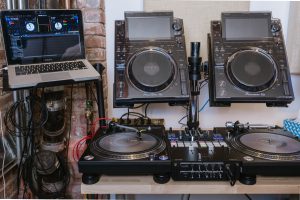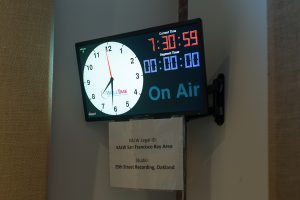KALW opens Oakland studio, expands music lineup with six new DJs in 80th year
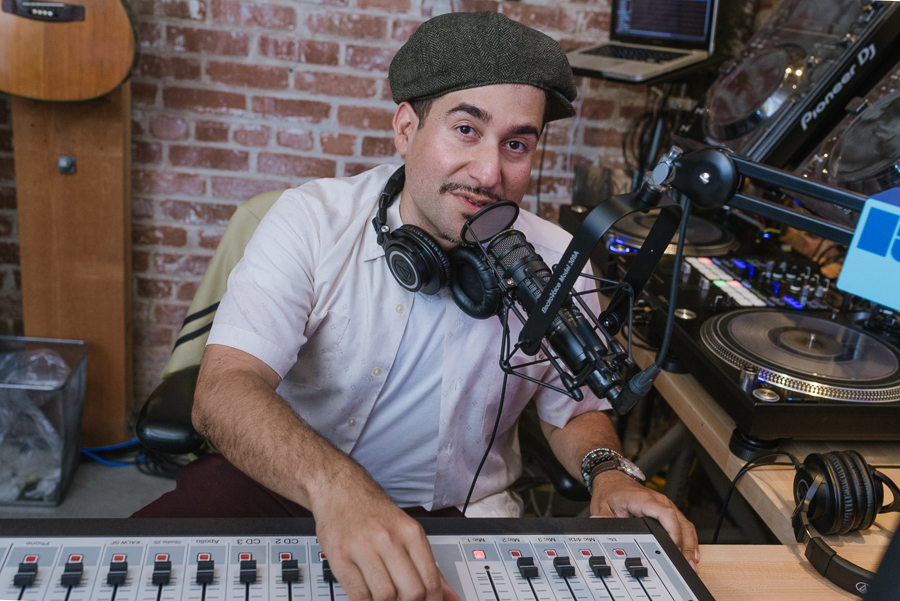
Juan Amador (DJ Wonway Posibul) tests his equipment before going on-air at KALW 91.7 at 25th Street Recording in Oakland on July 26, 2021. Karen Goldman/STAFF.
The oldest FM radio station west of the Mississippi is making a concerted effort to better speak to Bay Area music listeners by opening a second broadcast studio in Oakland, expanding its DJ lineup to include more diverse voices, and promising to hold itself more accountable to diversity, equity and inclusion efforts. KALW 91.7 FM is marking its 80th anniversary in 2021, and as part of its new identity, rebranded and last week began broadcasting from 25th Street Recording in Oakland.
“I see the station as a place of handmade public radio. We’ve always done that well with news and information podcasts, and culture podcasts,” KALW General Manager Tina Pamintuan said. “We also had this great music programming; however, we had less music programming than we had news and information programming. … My team really felt that we could be this destination—this territorial voice—of music discovery in the Bay Area.”
The socially minded KALW first went on-air in September 1941, 30 years prior to NPR. During World War II, it was the first radio station to train women in radio broadcasting. It was also the first station in the Bay Area to air critically acclaimed shows like “Fresh Air,” “This American Life” and “Snap Judgment.” For decades, it was the BBC’s station of record in San Francisco. It’s also known for its tuition-free journalism training program for teens, as well as inmates at San Quentin and Solano State prisons.
The station has broadcast music discovery programs of numerous genres with shows like “Tangents,” “Africa Mix,” “Revolutions Per Minute” and “Folk Music and Beyond.” But Pamintuan said she wants KALW to become a trusted source of music discovery in a more meaningful, connected way, while also supporting Bay Area artists by giving them a platform to succeed—“where they have a home and where people can hear their music.”
“We had seen with changes over time that there was not a radio station that was occupying that space,” she said.
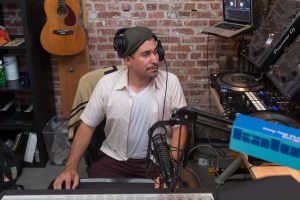
Juan Amador (DJ Wonway Posibul) tests his equipment before going on-air at KALW 91.7 at 25th Street Recording in Oakland on July 26, 2021.
To that end, Pamintuan has hired six DJs well-known in the Bay Area: Wonway Posibul (Juan Amador) from 8 to 10 p.m., Monday through Friday, followed by a rotation from 10 p.m. to midnight that includes DJ Umami (who DJs at Warriors games), King Most, LadyRyan, J Boogie and Margarita Azucar.
The DJs were recruited by KALW’s new music programming advisor, longtime KCRW DJ Aaron Byrd, whom Pamintuan brought onboard in February to reimagine the station’s music programming.
“What I found at KALW, and with all the public radio stations that I listened to in the Bay Area, was that it was very stereotypical of public radio in the sense that there was nothing but specialty shows,” Byrd said.
Los Angeles station KCRW, on the other hand, isn’t siloed in such a way, and from moment to moment, listeners can hear many different types of music. When listeners who might not be fan of reggae tune in to a station and find themselves in the middle of a reggae show, they’re likely to tune out right away.
But that’s a hallmark of public radio, where most stations dedicate a show to each type of genre.
The new DJ lineup began broadcasting from the Oakland studio on July 19, and listeners quickly found themselves in programs that combined cumbia, hip-hop, jazz, classic rock and classical music—sometimes all within the same 20-minute block.
“You now have five different audiences being served at the same time in one program,” Byrd said.
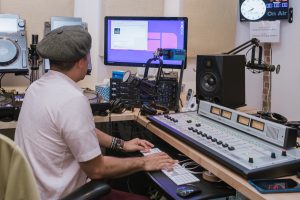
Juan Amador (DJ Wonway Posibul) tests his equipment before going on-air at KALW 91.7 at 25th Street Recording in Oakland on July 26, 2021.
Of the six news DJs at KALW, only three have previous on-air radio experience.
“It’s such a KALW thing to do training and mentoring,” Pamintuan said. “It’s part of the culture at the station, where we are open to talent that might be coming from somewhere else.”
Of the six new DJs, Amador (Wonway Posibul) has the most experience. Having a primetime platform, a say in what’s played and getting paid for the work was unheard of for him, he said. In 20 years of experience, he’s never made money in radio work.
His first week on the air, he played a diverse playlist that included Régine, Dom Jones, Orishas Afro-Cuban salsa, South African artist Sio and underground MC Elzhi alongside the Doors and a birthday celebration for Carlos Santana.
“I want to highlight music that doesn’t get the shine I think it properly deserves; whether that’s older music that’s been forgotten about; whether that’s newer independent music or music coming from local artists,” Amador said. “Every genre is badly needing that.”
One week in, he’s already heard from listeners all over thanking him for exposing them to something new.
“I feel honored that I’m in this position and get to share stuff,” he said. “I wish I had this when I was a kid.”
Pamintuan credits Byrd for the station’s new music focus and vision and said she doesn’t remember someone of his pedigree working with KALW in its 80 years. Although he’s working on a contract basis, his fingerprints are everywhere.
Amador said KCRW itself is a role model for KALW in regard to music discovery and that Byrd “provided a lot of valuable insight.”
Of the three DJs with prior radio experience, all were trained in the more stereotypical siloed program. Byrd, in turn, worked with them to define and pursue music that was eclectic. Training went on for weeks. Byrd provided examples and then they would find their own versions of what “eclectic” meant.
“It was intentionally not specific: Any and all. Uptempo and down-tempo, fast songs, slow songs, in addition to variety of genres,” he said. “I would push them to get out of their comfort zones.”
But he chose all six because he liked listening to them talk, their taste in music, and the ways in which their musical preferences overlapped yet still had a unique perspective.
“Margarita Azucar—she’s on Thursday nights from 10 to 12—she’s very clearly rock- and Latin-centric, while also playing dance music, hip-hop and other songs from around the world,” he said. “LadyRyan is originally from Washington, D.C., but she’s been in the Bay for about 21 years. D.C. is the home of go-go music, so she’s maybe a little more dance-centric, and a little more soul-centric. But she surprised me with one of her demos by throwing in a Rod Stewart song.”
Pamintuan said she hopes that listeners will connect with the new voices, while the DJs help listeners better understand the stories of the music they play. While algorithms increasingly dictate what music people are exposed to, music should remain a human form of communication. The stories and connection will help listeners discover new types of music to which they may not have previously been exposed.
Public radio DJs have a greater sense of responsibility and duty to serve everyone, rather than fans of one genre, Byrd added.
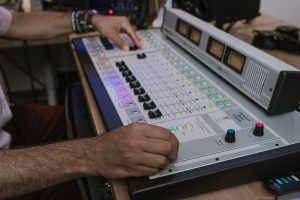
Juan Amador (DJ Wonway Posibul) tests his equipment before going on-air at KALW 91.7 at 25th Street Recording in Oakland on July 26, 2021.
“It’s through the magic of the DJ and the connective thread and tissue they weave in their sets,” Pamintuan said. “There are genres, but genres connect. … I think public radio listeners are hungry and curious people in terms of learning about new music, news and culture. It’s right up the ally of public radio listener.”
Amador added that listeners traditional and new alike will find themselves falling in love with something either completely new or be reminded of a past love.
“I’m a firm believer that music is medicine and it’s healing. In these times, we could all use that,” he said.
The 2021 hires were preceded by KALW forming a nonprofit (KALW Public Media) in 2019 and 2020. Though the San Francisco Unified School District has owned the station’s license since the station’s inception, a new agreement with the school district allows the station to fundraise for itself and get access to grants that would not otherwise go to a government agency, which the school district is. This agreement allowed the station the ability to hire directly rather than going through the civil service system.
And although the station had already been focusing on diversifying its staff, Pamintuan said she needs to set an example for others to create engaging and useful content for diverse, traditionally marginalized listeners. The station also increased its commitment to a more inclusive and equitable public media by tracking real-time performance and impact on DEI issues. It will document whose voices KALW brings to the air (who’s reporting, editing and featured in its stories) and how the communities the station serves are engaging with this reporting.
Pamintuan said that in 2018 or 2019 data, the most recent she has, only 0 to 4 percent of KALW listeners were Black or Latinx, which is reflective of the public radio industry.
“I have seen over time how we haven’t been serving diverse communities across the country,” she said. “When I look at a market like the Bay Area, the fourth largest market, our public media should be serving them in a way that is deep, genuine and engaged.”
Added Byrd: “It was very important to me, when engaging with a potential new talent … that they understood that it was very important from my philosophical approach that both the programming and the programmers reflect the demography that they’re serving.”
Follow editor Roman Gokhman at Twitter.com/RomiTheWriter. Follow photographer Karen Goldman at Twitter.com/Xposure120 and Instagram.com/XposureArts.

